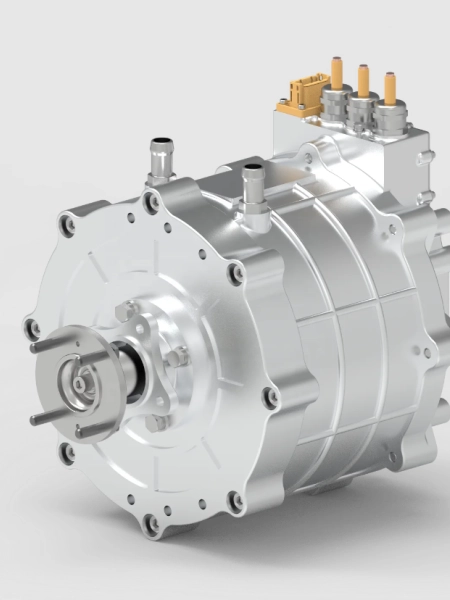
Over the past decade, the automotive industry landscape has undergone a significant transformation thanks to the advancement of electrical technology.
Electric motors have emerged as a promising alternative to internal combustion engines, driving innovation and the adoption of more efficient and environmentally friendly vehicles.
In this article, we will explore the different types of electric motors used in modern electric cars and how they are changing the transportation landscape.
Types of electric motors
Electric motors are the heart of electric vehicles, converting electrical energy stored in batteries into mechanical energy to propel the vehicle.
Here is a description of the most common types of electric motors used in the automotive industry:
Permanent Magnet Synchronous Alternating Current (AC) Motors:
These motors use permanent magnets mounted on the rotor to generate a rotating magnetic field. By feeding the stator with three-phase alternating current, a stationary magnetic field is induced that interacts with the rotor field, generating movement.
These motors offer high efficiency and a wide operating speed range, making them a popular choice for many high-end electric vehicle manufacturers.
Variable Reluctance Alternating Current (AC) Motors
Variable reluctance AC motors use the magnetic reluctance of ferromagnetic materials in the rotor to generate motion.
Magnetic reluctance is a property of ferromagnetic materials that causes them to resist magnetic flux. In a variable reluctance motor, the rotor is composed of ferromagnetic materials that have the ability to change their magnetic reluctance when exposed to a magnetic field.
When the motor stator is powered with alternating current (AC), a rotating magnetic field is created that interacts with the rotor. The way the ferromagnetic materials in the rotor respond to this changing magnetic field is what generates the motion. That is, the magnetic reluctance of these materials changes as the stator's magnetic field rotates, causing the rotor to also rotate.
Unlike permanent magnet synchronous motors, these motors do not require permanent magnets in the rotor, which can reduce costs and simplify design.
Brushed Direct Current (DC) Motors
These motors use brushes and commutators to reverse the direction of current in the rotor, generating a rotating magnetic field.
Although they are less common in modern electric vehicles due to their lower efficiency and higher maintenance, they can still be found in some older models or specific applications.
Brushless DC Motors
Brushless DC motors eliminate brushes and commutators, using control electronics to switch current in the stator. This results in higher efficiency and longer life compared to brushed DC motors.
Switched reluctance synchronous motors
These motors combine the characteristics of synchronous motors and reluctance motors. The rotor is made up of protruding iron poles that generate a reluctance torque. Switching is achieved by varying the magnetic flux, resulting in good efficiency and higher power density.
Presence in the international market of each type of engine
The market share of each type of engine can vary depending on multiple factors in a very short space of time.
However, below we provide a table with a general estimate based on historical trends:
|
Electric motor type |
Estimated percentage in the international market |
|
Permanent Magnet Synchronous Alternating Current (AC) Motors |
40% - 50% |
|
Variable Reluctance Alternating Current (AC) Motors |
10% - 20% |
|
Brushless DC Motors |
20% - 30% |
|
Brushed Direct Current (DC) Motors |
5% - 10% |
|
Switched reluctance synchronous motors |
5% - 10% |
It is important to keep in mind that these percentages are approximate. Additionally, the market share of each type of electric motor can change over time as technology advances and new innovations are developed in the automotive industry.
Engines used by car brands
The adoption of electric motors has been embraced by a variety of market-leading automotive brands. From Tesla to Nissan, companies are betting on electric technology to drive the future of mobility.
Below is a table summarizing some of the car brands and the types of electric motors they typically use:
|
Brand |
Engines |
|
Tesla |
Permanent Magnet Synchronous AC Motors |
|
Nissan |
Variable Reluctance AC Motors |
|
Renault |
Brushed DC Motors/Permanent Magnet Synchronous Motors |
|
BMW |
Brushless DC Motors |
|
Chevrolet |
Switched reluctance synchronous motors |
|
Audi |
Permanent Magnet Synchronous AC Motors |
|
Jaguar |
Permanent Magnet Synchronous AC Motors / Brushless DC Motors |
|
Hyundai |
Permanent Magnet Synchronous AC Motors |
|
Come on |
Permanent Magnet Synchronous AC Motors |
|
Ford |
Permanent Magnet Synchronous AC Motors |
|
Volkswagen |
Permanent Magnet Synchronous AC Motors |
|
Mercedes-Benz |
Permanent Magnet Synchronous AC Motors |
|
Porsche |
Permanent Magnet Synchronous AC Motors |
|
Volvo |
Permanent Magnet Synchronous AC Motors |
|
MG |
Permanent Magnet Synchronous AC Motors |
|
WORLD |
Permanent Magnet Synchronous AC Motors / Variable Reluctance Motors |
Table 1: Car brands and their electric motors


